How Big of a TV Do I Need for My Room?

Of course, a television can always be bigger or smaller than expert recommendations, but knowing where to start can help you make a more informed decision. Read our blog to learn how big of a TV you need for your room.
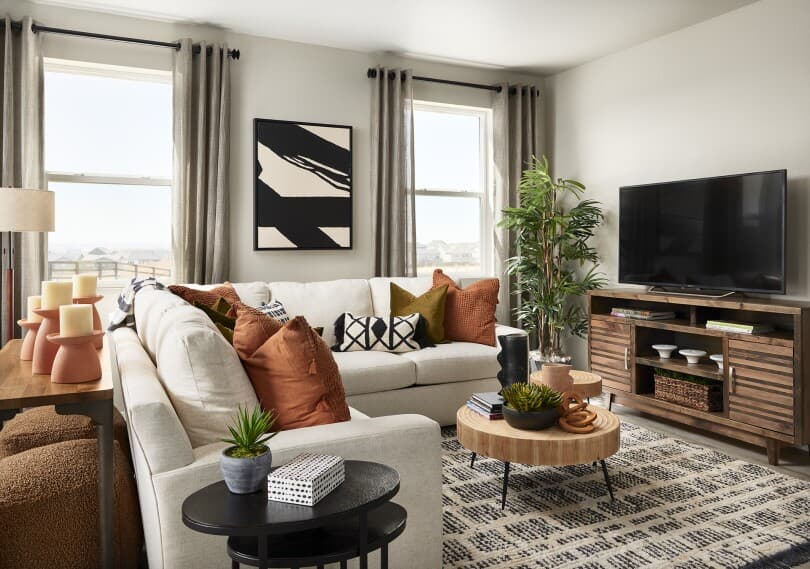
What to know when TV shopping
There are technical aspects you should know before you begin shopping for a television. The most important are:
1. Screen size
TV screens are measured in inches – diagonally from corner to corner, not side to side. It’s pretty basic, but something you must know before you can start shopping. The most popular living room TV sizes are 55- to 65-inch models, while bedrooms or offices commonly use TVs under 45 inches.
2. Resolution
The TV resolution determines the level of detail and clarity of the picture. Common resolutions include Full HD (1080p), 4K Ultra HD (2160p), and 8K Ultra HD (4320p). Higher resolutions offer a clearer picture, meaning you can sit closer to a 4K TV than a 1080p TV without eye strain.
3. Display technology
The type of display technology used in the TV determines the picture quality. The most common types of display technologies include LED, OLED, and QLED. Each technology has several technical differences, and each has its pros and cons. Once you know the differences, you can better determine the best fit for your needs.
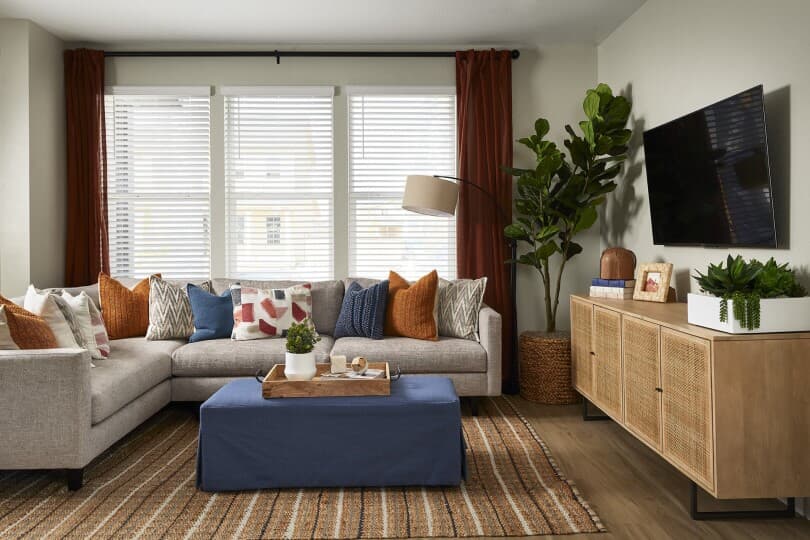
How to determine TV viewing distance
The distance between your furniture and the TV depends on the TV size and your room layout. Whether you have an open-concept living area and can choose the furniture placement however you desire or have a set layout based on your bedroom size, the goal is comfortable viewing without straining your eyes or neck.
Experts recommend sitting at a distance of about 1.5 – 2.5x your television’s screen size. In general, larger TVs closer to the viewer offer better picture quality and a more immersive experience. You also need to find a balance between viewing distance and TV size. If you dream of a 75-inch TV in your primary bedroom, that may be too big for the available space. You may be better off opting for a smaller screen size but a higher resolution.
|
Distance From TV |
Minimum Screen Size |
Ideal Screen Size |
Maximum Screen Size |
|
2 – 3 Feet |
25 inches |
32 inches |
40 inches |
|
4 – 5 Feet |
30 inches |
42 inches |
50 inches |
|
6 – 7 Feet |
45 inches |
55 inches |
70 inches |
|
8 – 9 Feet |
60 inches |
75 inches |
85 inches |
|
10 – 12 Feet |
75 inches |
85 inches |
98 inches |
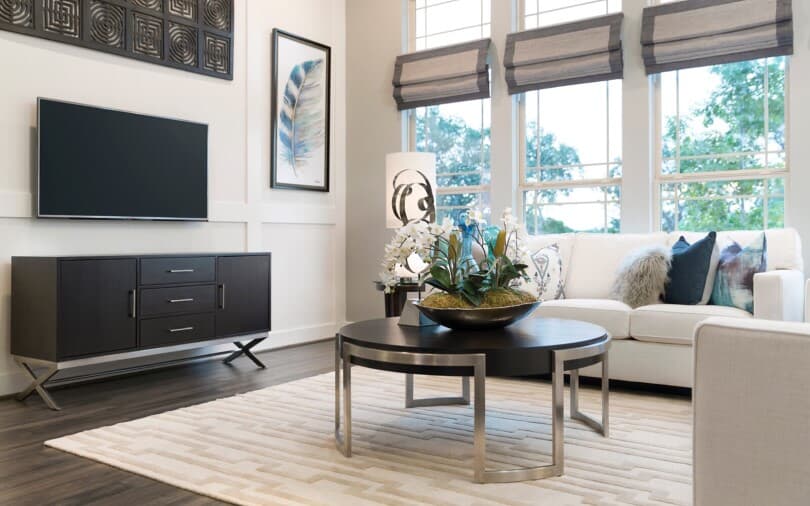
Consider the field of view
Field of view refers to the screen area you can see when you’re sitting in front of it without having to move your eyes or head too much. Generally, the larger the TV screen, the larger the field of view, but you’ll need to sit farther away to see the entire screen.
How do you figure out the ideal field of view for your space? Multiply the TV screen size by 1.2. For a 50-inch set, a reasonable distance would be about 5 feet. This calculation assumes you can adjust your furniture placement, but if your layout only works with a specific setup, start with the viewing distance available and divide by 1.2.
We know it’s a bit math-heavy, but stay with us! If you measure your living space and find that you have 8 feet from your couch to your TV stand, the largest TV screen you could have is 80 inches. You can always go smaller if needed but don’t go over what you calculate.
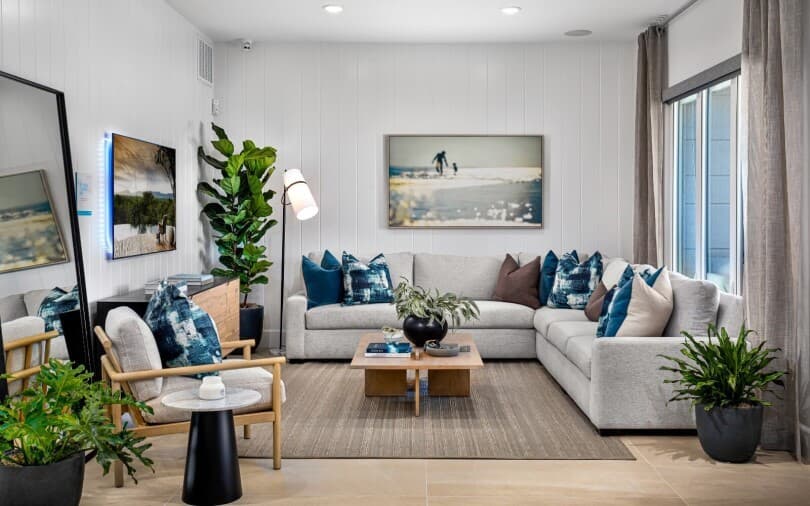
Determine where the TV will be installed
Having a media cabinet with an existing TV opening limits your screen sizes. You’ll want to measure the cabinet opening on the diagonal and buy the biggest TV that will fit with enough clearance to access any rear or side connections.
There’s greater flexibility when using a TV stand or wall mount. Remember that TV stands are typically measured horizontally, while screens are measured diagonally. You’ll want to double-check the television’s overall dimensions to ensure it fits correctly on your stand.
Hanging the TV on the wall can add a foot or more to the viewable distance, which can be the difference between a 60-inch and 72-inch model. Adjustable mounts with tilting and telescopic options provide even more screen size and viewing angle flexibility. Added bonus? You free up valuable floor space in the room.

Consider your budget
Bigger isn’t always better, and that includes the price tag. Larger TVs with the absolute best picture quality will have a corresponding cost. If your budget doesn’t allow for that top-of-the-line 75-inch TV, you’ll be better off going smaller and staying at an affordable price. Fortunately, as technology improves and televisions with higher resolutions become more available, larger screen sizes have become more common and, therefore, more affordable.
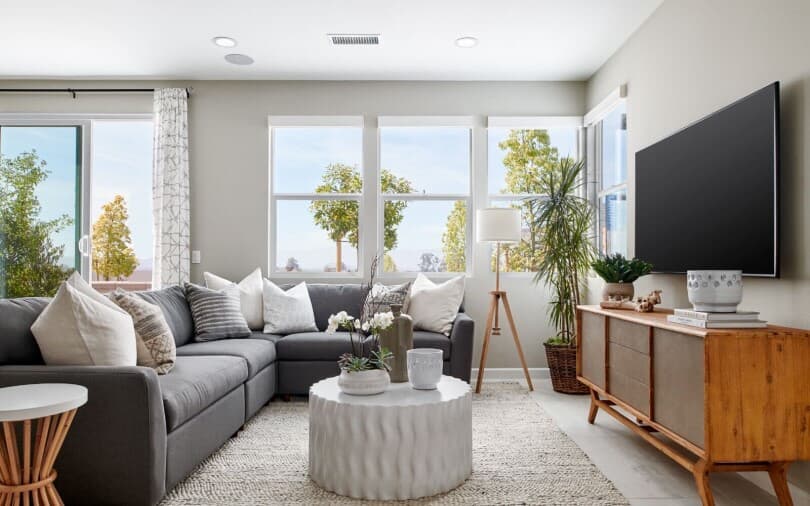
Ultimately, deciding how big of a television you need for your space comes down to balancing screen size, the size of your room, and your budget.
Be sure to check out the Brookfield Residential blog for more design advice, homebuying insights, mortgage tips, and more, including arranging furniture like a pro and bringing balance through feng shui home design.
You can also explore where we build and connect with our sales team when you’re ready to learn more. We’ll be expecting you!
